Return With Us Now
To Those Shocking Days of Yesteryear
...
Ellen R. Kuhfeld
Many of the effects used in modern electromagnetic medicine and studied in
modern research are subtle. Elaborate methodologies are needed to prove their
existence, let alone their efficacy. It has not always been thus. Touch a
doorknob in January, put your finger in the wrong socket, grasp the wrong fish
-- and you know electricity has happened to you. Your muscles twitch, your
nerves tingle and grow numb.
Your muscles twitch: that's exercise. Your nerves tingle and grow numb: that
can be the relief of pain. Throughout history, much of medicine has been the
relief of pain, and getting the weak back to strength. Electricity can do things
a rational medicine would seize upon and treasure.
The first records of medical electro-stimulation come to us from the Romans.
Scribonius Largus 1 wrote in the first century A.D.
that
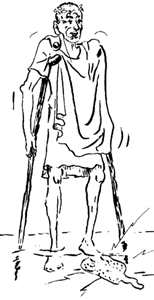 "For any type of gout a live black torpedo should, when
the pain begins, be placed under the feet. The patient must stand on a moist
shore washed by the sea and he should stay like this until his whole foot and
leg up to the knee is numb. This takes away present pain and prevents pain from
coming on if it has not already arisen. In this way Anteros, a freeman of
Tiberius, was cured...."
"For any type of gout a live black torpedo should, when
the pain begins, be placed under the feet. The patient must stand on a moist
shore washed by the sea and he should stay like this until his whole foot and
leg up to the knee is numb. This takes away present pain and prevents pain from
coming on if it has not already arisen. In this way Anteros, a freeman of
Tiberius, was cured...."
Claudius Galen 2 added
"The whole torpedo, I mean the sea-torpedo, is said by some to cure
headache and prolapsus ani when applied. I indeed tried both of these things and
found neither to be true. Therefore I thought that the torpedo should be applied
alive to the person who has the headache, and that it could be that this remedy
is anodyne and could free the patient from pain as do other remedies which numb
the senses: this I found to be so. And I think that he who first tried this did
so for the above-mentioned reason."
Here we have the electric torpedo fish of the Mediterranean -- capable of
fifty volts and several amps, moist with salt water for good conductivity --
being used live in medicine. And it is used in familiar ways: relief of pain in
gout and headache, muscular stimulation in prolapsus ani. (Presumably in the
latter, the abdominal muscles would contract and draw the anus back in.)
In China, the electric catfish parasilurus asota was recommended for
drooping of the eyelid and for facial palsy, as in this prescription from a
classic pharmacopeia (Li, 1596): 3
"Cut the tail part from a live catfish and place it directly on the
paralyzed spot every morning. The drooping is immediately corrected."
As the centuries wore on, the use of electricity languished. Doctors and
pharmacists might be willing to keep a supply of leeches: small, sluggish,
available in your friendly local swamp, they are no problem. Live ocean fish are
quite another matter. But early in the eighteenth century, Francis Hauksbee the
Elder noticed he had accidentally made an electrostatic generator while
researching the "mercurial phosphor" in a vacuum. With this new technology, the
study of electricity spread. In 1743 the students at Halle in Germany asked for
their new professor's thoughts. Johann Gottlob Krüger replied, 4
... all things must have a usefulness; that is certain. Since electricity
must have a usefulness, and we have seen that it cannot be looked for either in
theology or in jurisprudence, there is obviously nothing left but
medicine."
Medical men -- and dilettantes -- tried electricity. Cures were reported, of
pain and paralysis and stiffness. But the shocks were mild, your basic
shuffle-across-the-carpet-and-touch-the- radiator. An undeniable cure awaited
the invention of the Leyden Jar capacitor in the winter of 1745-46. There was a
shock that could loosen your teeth!
On December 26, 1747, a locksmith named Nogues paid a visit to Jean
Jallabert, professor of experimental philosophy and mathematics at Geneva. More
than fourteen years earlier, Nogues had suffered an accident while forging a bar
of iron. A false blow had thrown him backwards, unconscious. After some days he
recovered consciousness but was paralyzed on the right side and unable to speak.
After prolonged treatment he was able to walk with a limp, his speech returned,
and there was slight movement of the right arm.
Jallabert, together with Daniel Guiot, the leading surgeon of Geneva,
examined the patient. All sensation was lost in the right arm, and the wrist was
bent towards the forearm. The thumb, index, and little fingers were bent and
fixed to the palm. A slight power of movement remained in the middle and ring
fingers, and the arm could just be raised or lowered, but no other movements
were possible. The arm was emaciated, and the fingers swollen.
With Guiot witnessing the first trial, Jallabert delivered a shock. Nogues'
healthy hand held the Leyden Jar, and his paralyzed hand touched it. Jallabert
then insulated Nogues on wax, electrified him, and drew sparks from the various
muscles of the forearm. He noticed at once that the muscles were "convulsed" and
the wrist and fingers agitated. Jallabert immediately had Guiot administer the
same treatment to himself, and found similar muscular contractions.
Jallabert began systematic treatment, for about an hour and a half each day.
He used a short metal rod with a rounded head to direct the electricity
precisely to the muscle being treated, with three or four shocks being given to
each. The arm was massaged before and after treatment as it lay on the warm
surface of a stove.
By January 10, on Guiot's third visit to the patient, he was astonished at
the improvement. The arm was less emaciated, and all fingers but the little
finger and thumb could be extended. By January 28 the patient could pick up a
full glass of water. During February Jallabert worked to strengthen the muscles
of the upper arm, and Nogues began a course of exercise with weights and
movements. Treatment ended in March with complete use of the arm regained.
Eventually the locksmith returned to his old trade. 5
What happened here seems obvious. A blow on Nogues' head caused brain damage,
the equivalent of a stroke. (Alternatively, a stroke caused the false blow.)
Half his body became paralyzed. Muscles atrophied. When the brain learned to
route signals around the damaged area, some muscles had atrophied so thoroughly
they could not react.
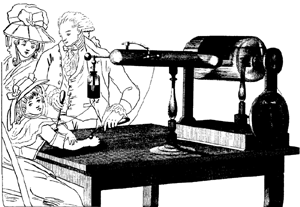 But if you massage and warm those muscles, and discharge a
joule or so of electrical energy into them in a microsecond, even an atrophied
muscle will snap to attention. Electrostimulation exercised the muscles to a
point where conventional physical therapy could complete the job.
But if you massage and warm those muscles, and discharge a
joule or so of electrical energy into them in a microsecond, even an atrophied
muscle will snap to attention. Electrostimulation exercised the muscles to a
point where conventional physical therapy could complete the job.
John Wesley, founder of Methodism, was concerned with the pain and misery
suffered by the poor, and was critical of the medical profession for its use of
compounded remedies. These brought profit to doctor and pharmacist alike, and
cost too much for many to afford. In 1759 he published The desideratum: or,
Electricity made plain and useful. By a lover of mankind, and of common
sense. By his lights electricity was an excellent medicine. Once you paid
for the equipment you could treat suffering humanity all day with no further
expenditure save the energy needed to turn the crank.
Electricity was not only good medicine, it was positively lifesaving. In his
1788 Essay upon the recovery of the Apparently Dead, Charles Kite
recommended electrical shocks from a Leyden jar, applied to the chest to revive
a stopped heart. He noted electricity's powerful effect upon the human frame:
6
"And are we not justified in presuming, that if it is able so powerfully
to excite the action of the external muscles, that it will be capable of
reproducing the motion of the heart, which is infinitely more irritable, and by
that means accomplish our great desideratum, the renewal of the
circulation?"
(Kite's Essay... was, I might add, a review article. He mentioned
several successful resuscitations in earlier years to bolster his
arguments.)
Electricity was becoming associated with the life force -- so much so that
when Luigi Galvani discovered "animal electricity" upon the martyred bodies of a
thousand frogs, his announcement 7 sent scientists
across Europe into their laboratories. Truly unexpected discoveries are not
received so enthusiastically. The general reaction seems to have been, "At last!
He's found where the Vital Principle is hiding!"
One of the scientists was Alessandro Volta. He initially accepted Galvani's
theory of an animal origin for the electricity. As his experiments continued, he
began to think of bimetallic electricity. In 1800 he announced what immediately
was called the Voltaic Pile. 8
Controversy raged. Was Galvani right, or Volta? Both were right, and both
were wrong. Galvani thought he had obtained electricity from animal tissues. He
had actually discovered the bimetallic arc -- a crude form of electrochemical
cell. Volta thought his electricity was created by the contact of two dissimilar
metals. It actually came from an electrolyte in contact with those two metals.
Each man and his supporters devised ingenious demonstrations. Huge amounts of
science were done in a very short time. All was eventually proven: what they
thought they had discovered -- and what they really had discovered.
 Jean Aldini, Galvani's nephew and collaborator, was a noted
student of the new animal electricity. Using a voltaic pile, he performed a
series of terrible public experiments upon the bodies of executed murderers. He
found they retained muscular irritability for two hours after death, and that he
could excite many of the motions of life.
Jean Aldini, Galvani's nephew and collaborator, was a noted
student of the new animal electricity. Using a voltaic pile, he performed a
series of terrible public experiments upon the bodies of executed murderers. He
found they retained muscular irritability for two hours after death, and that he
could excite many of the motions of life.
Some feared Aldini and the other Galvanists would indeed return a murderer to
life. The legal questions were daunting, let alone the moral questions. Aldini
stirred the mixture by suffocating a dog to the point of cardiac standstill,
then resuscitating it with thoracic shocks from a Voltaic pile.
Mary Shelley was thinking of these experiments when she wrote
Frankenstein. 9 "Perhaps a corpse would be
re-animated; galvanism had given token of such things...."
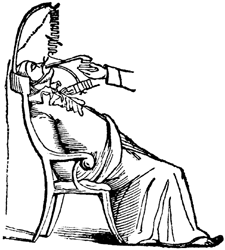 Frankenstein was first published in 1818. Richard
Reece, MD, published a family medical guide at roughly the same time. 10 In one of his chapters we meet the "Re-Animation Chair
of Doctor De Sanctis". In a vision echoing the researches of Aldini and
Frankenstein, De Sanctis had devised a sort of "Code Blue" apparatus. It was a
reclining chair whose resuscitation equipment included a bellows with laryngeal
tube to inflate the lungs, a heated globe to create inhalant vapors -- and a
Voltaic pile.
Frankenstein was first published in 1818. Richard
Reece, MD, published a family medical guide at roughly the same time. 10 In one of his chapters we meet the "Re-Animation Chair
of Doctor De Sanctis". In a vision echoing the researches of Aldini and
Frankenstein, De Sanctis had devised a sort of "Code Blue" apparatus. It was a
reclining chair whose resuscitation equipment included a bellows with laryngeal
tube to inflate the lungs, a heated globe to create inhalant vapors -- and a
Voltaic pile.
" The brain and the heart should be stimulated by passing through them the
Galvanic fluid. [...] one of the wires is to be applied to the [silver] tube
passed down the gullet, whilst the other is to be successively made to touch
different parts of the external surface of the body, particularly about the
regions of the heart, the diaphragm, and the stomach during the inflation of the
lungs...."
In short, De Sanctis recommended cardiac electrostimulation via esophageal
and precordial electrodes, in an attempt to get a stopped heart beating again.
This is little different in concept from defibrillation and external pacing as
they are practiced in modern medicine.
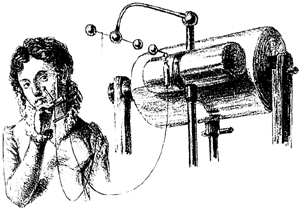 Nor was pain neglected in the nineteenth century. Charles
Bew recommended facial electrostimulation to relieve the pain of tic douloureux.
11 Bew used an electrostatic discharge similar to
that of Kite's defibrillator, though with a smaller Leyden jar.
Nor was pain neglected in the nineteenth century. Charles
Bew recommended facial electrostimulation to relieve the pain of tic douloureux.
11 Bew used an electrostatic discharge similar to
that of Kite's defibrillator, though with a smaller Leyden jar.
Electrostatic machines gave powerful single pulses. Many people felt that
getting their electrotherapy in one instantaneous blast was little better than
the pain it drove away. When the induction coil was invented, medicine had a
gentler source which gave a rapid, continuous train of pulses quite like the
output of a modern TENS stimulator. Tripier 12
said:
"M. Francis (of Philadelphia) has announced that Faradization of teeth
renders their extraction infinitely less painful, after assessing the results of
a large number of trials of this method of anesthesia. A dentist of Geneva
recommends attaching the dental key or forceps to the negative lead of a medical
induction coil, while the patient holds the positive electrode in his hand. The
tooth should be extracted immediately after the application of the electrified
forceps."
Perhaps the most prescient early use of the induction coil was that of Henry
Hall Sherwood, 13 as described in his 1845 Manual
for Magnetizing ... Despite the title, Sherwood used pulsed electricity. The
induction coil was still young, and terminology had not settled down. His coil
made its pulses of electricity through electromagnetic induction.
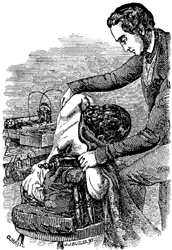 Sherwood treated curvature of the spine. The Manual says he
"had 67 cases of lateral curvatures of the spine from the 1st of April to the
8th of Oct. 1844 ..." He found "The muscles are always swelled,
thickened, or tuberculated on the posterior side of the curve ... and emaciated
or atrophied and paralyzed on the other." To exercise and strengthen the
weakened muscles, he and a therapist stimulated them with his machine.
Eventually he developed a specialized chair to hold the patient in proper
position for the treatment.
Sherwood treated curvature of the spine. The Manual says he
"had 67 cases of lateral curvatures of the spine from the 1st of April to the
8th of Oct. 1844 ..." He found "The muscles are always swelled,
thickened, or tuberculated on the posterior side of the curve ... and emaciated
or atrophied and paralyzed on the other." To exercise and strengthen the
weakened muscles, he and a therapist stimulated them with his machine.
Eventually he developed a specialized chair to hold the patient in proper
position for the treatment.
Guillaume Benjamin Amand Duchenne began to study the interaction of
electricity and the human body. In 1835, attending a patient suffering from
neuralgia, he tested the effects of electropuncture. This had been introduced to
Europe, ten years earlier, by Sarlandière. 14
Duchenne noticed that on closing the circuit a single muscular contraction
occurred, limited to the site of the puncture. Repeated trials convinced him it
was possible to confine the effects of electricity to individual nerves and
muscles.
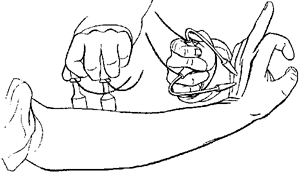 And so, Duchenne used electrical stimulation to map out
nerves and muscles, with increasing sophistication. 15 The use of electricity in physical therapy and diagnosis
was becoming very nearly respectable. In America, George Beard and Alphonse D.
Rockwell published Medical and Surgical Electricity, which was to go
through ten American editions. 16 Shortly thereafter,
Rockwell was refused permission to read a paper on the subject before the New
York Medical Society. They felt electrotherapy was advocated only by quacks. It
was not until 1877, when S. Weir Mitchell endorsed exercise of muscles by
faradic current, that Beard and Rockwell were accepted as equals by their fellow
physicians. 17
And so, Duchenne used electrical stimulation to map out
nerves and muscles, with increasing sophistication. 15 The use of electricity in physical therapy and diagnosis
was becoming very nearly respectable. In America, George Beard and Alphonse D.
Rockwell published Medical and Surgical Electricity, which was to go
through ten American editions. 16 Shortly thereafter,
Rockwell was refused permission to read a paper on the subject before the New
York Medical Society. They felt electrotherapy was advocated only by quacks. It
was not until 1877, when S. Weir Mitchell endorsed exercise of muscles by
faradic current, that Beard and Rockwell were accepted as equals by their fellow
physicians. 17
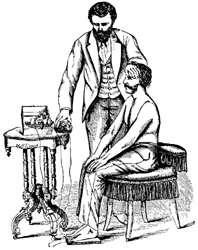 By the twentieth century, electrical stimulation of muscles
in physical therapy was an accepted treatment. But one muscle was still
off-limits: the heart. It made sense. One false move with the heart -- and there
goes the patient. That sort of thing tends to discourage experimentation.
By the twentieth century, electrical stimulation of muscles
in physical therapy was an accepted treatment. But one muscle was still
off-limits: the heart. It made sense. One false move with the heart -- and there
goes the patient. That sort of thing tends to discourage experimentation.
You can't be killed if you're already dead. Thus, electricity was applied to
the heart only in the most desperate cases. That was Kite; that was De Sanctis;
and in the 1930s, that was Albert Hyman. Hyman had graduated from the Harvard
Medical School in 1918, and was very interested in cardiac resuscitation. 18
His first experience with a human patient came in 1918, with a 44-year-old
man whose heart stopped in the Emergency Room. Hyman noted, "It had long been
known that in certain instances of sudden death, for example, on the operating
room table, active massage of the heart or injections of cardio-stimulating
drugs like adrenalin might restore automatic activity to the heart." This
patient died, as did all but thirteen of the eighty-one cases he observed during
the next six years of hospital duty.
In subsequent research he found "...that the most important factor in all
of the intracardial injection procedures was the actual puncture of the heart
wall. As a result of the puncture wound an action current of injury ...
developed ... of much greater difference of electric potential than the
intrinsic sinus nodal pacemaker stimulus ..." And he concluded, "If,
instead of waiting for an uncontrolled ectopic stimulus to be generated from the
needle injury, an artificial electric stimulus, more or less identical with the
normal sinus pacemaker stimulus, could be delivered to the atrial area near the
sinus node ... the artificial pacemaker would take over the functions of the
normal sinus pacemaker until such time as the latter could assume its normal
activity."
He developed and assembled such an apparatus, and said, "By March 1, 1932.
the artificial pacemaker had been used about 43 times, with a successful outcome
in 14 cases." Hyman was beset with abusive correspondence, and even
lawsuits, from irascible people who regarded his resuscitation endeavors as
sacrilegious tampering with Divine Providence. Despite this he persisted; and
even used his pacemaker in Adams-Stokes disease.
With the development of open-heart surgery in the 1950s, the need grew for
some means to keep a stalled heart beating. Repair of a septal defect could
traumatize the normal conduction system of the heart; it would not re-start
after surgery. C. Walton Lillehei at the University of Minnesota began suturing
insulated stainless-steel wires to the heart before closing the chest. Pacing
impulses could be delivered through this wire for a week or so until the heart
healed. Then the wire could be withdrawn with a simple pull. 19
Use of this pacemaker for a week edged closer to long-term use. And it
exposed the patient to more than the simple hazards of an experimental
treatment. Pacemakers were line-powered in these days, and when a power failure
took the life of one young patient, Lillehei called in Earl Bakken to "make
something that runs on batteries." 20 The rest is
history -- industrial history as well as medical, for this was the foundation of
Medtronic's fortune.
Today, with many thousands of people alive only through use of pacemakers, it
is impossible to ignore or scorn medical electricity. The question is no longer
"can electricity be good medicine?" That question has been answered. The
questions a given treatment must answer are "What are the benefits? What are the
hazards?"
The first undoubted electrical cure was in the middle of the eighteenth
century. Medical electricity did not gain widespread professional respect until
the twentieth century. During all those intervening years, there were
intelligent scientists and doctors doing intelligent things with electricity.
Why did medical electricity take so long to become respectable?
This article has been a list of high points. There were some very low points,
too. There were any number of charlatans and fools putting electricity (of which
they knew little) into bodies (of which they knew less). Charlatans were drawn
by the same aspects of electricity that drew the intelligent.
As was said in the first paragraph: when you get a shock, you know
electricity has happened to you. Electricity is impressive. At the same time it
is relatively safe, compared to the drugs and knives of the competition. This is
fertile ground for the quack, and for the placebo effect. Both the quack and the
placebo can sow confusion.
Then too, there is the state of medical knowledge of the day. Bleedings and
purges were common. Germs were unknown. The details of paralysis and sudden
death were a mystery. Jallabert cured one paralyzed hand, but as Marragues later
pointed out,
"Jallabert wrote of only one case of paralysis, his first, twenty-five
years ago. Certainly he must have tried electricity on others since and having
had no further success has maintained a profound silence." 21
Benjamin Franklin was more forthcoming.
"Some years since, when the newspaper made mention of great cures
performed in Italy or Germany, by means of electricity, a number of paralytics
were brought to me from different parts of Pennsylvania and the neighboring
provinces to be electrified; which I did at their request ... I do not remember
that I ever saw any amendment after the fifth day; which the patients
perceiving, and finding the shocks pretty severe, they became discouraged, went
home, and in a short time relapsed." 22
Some paralytics can be treated successfully; many cannot. If the physician
treats all comers, the incurable cases make the cure statistics for even the
most valid treatments look pretty grim. Until medicine understands paralysis,
all treatments will be judged failures.
Likewise with cardiac resuscitation. There's only a short time when
re-starting the heart does any good. How likely are you to be there, with the
apparatus ready? And even if you re-start it -- why did it stop in the first
place? What's to say it won't stop again?
Reviving victims of sudden death is a marginal therapy at best. Even with
modern medical knowledge, defibrillation doesn't have a very good record. Few of
the re-animated emerge from the hospital to take up a normal life again.
But the knowledge gained from re-starting stopped hearts is applicable. When
the physician knows a heart is in danger, the equipment can be prepared and at
hand. When a septal-defect repair leads to heart block in a youngster, a
pacemaker can tide the heart over until it's in shape to start beating again on
its own. Next thing you know, an elderly patient with Stokes-Adams is in the
next room from the kid. "Gee," thinks the doctor. "A pacemaker works on
kids with heart block ..." And therapy is revolutionized.
Science is a solution of facts, dissolved in a vast ocean of ignorance. Toss
something useful into the solution, and in the early days, it will seem to melt
away. But the ocean will have just a bit more fact in it, and be just a bit
closer to saturation. As science grows, and more facts are tossed into the
ocean, parts of it reach saturation.
And at that moment, a wee bit of fact tossed in will start facts
crystallizing into a solid piece of knowledge.
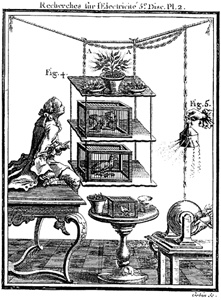 Few scientists ever throw a completely original fact into
the ocean. Most spend their lives finding and shovelling data to increase the
saturation of the sea. The lucky ones start a crystal growing.
Few scientists ever throw a completely original fact into
the ocean. Most spend their lives finding and shovelling data to increase the
saturation of the sea. The lucky ones start a crystal growing.
It took over a century for dense, readily-observed facts such as the twitch
of a person receiving a shock to reach saturation and begin to crystallize. The
effects of atmospheric electrification (which Nollet was studying back in the
1750s) 23 are more subtle. A solid datum is harder to
find. Argument is still more common than consensus. But some unexpected day,
everything will come together.
Look at it this way. The Babylonians began the study of astronomy, but it
took millennia for Galileo and Tycho and Copernicus to start the
crystallization. Medical uses of electricity are well ahead of astronomy in rate
of progress.
1 Quoted in Schechter, Charles, Electrical Cardiac
Stimulation (Medtronic, Minneapolis, 1983) pg 19
2 Quoted in Schechter, op cit pg 20
3 Wu, Chau H., "Electric Fish and the Discovery of Animal
Electricity", American Scientist November-December 1984
4 Quoted in Licht, Sidney, Therapeutic Electricity and
Ultraviolet Radiation (Second Edition, Baltimore, 1967) pp 3-7
5 This account chiefly taken from Rowbottom, Margaret and
Susskind, Charles, Electricity and Medicine: History of Their Interaction
(San Francisco, 1984) pp 15-17, supplemented by Licht, op cit pg 7.
6 Kite, Charles, Essay upon the Recovery of the Apparently
Dead (London, 1788)
7 Galvani, Luigi, De viribus electricitatis in motu
musculari (Bononiae, Ex Typographia Instituti Scientiarum, 1791)
8 Volta, Alessandro, "On the electricity excited by the mere
contact of conducting substances of different kinds" (in French),
Philosophical Transactions 90, 403-431, 1800
9 Shelley, Mary, in the introduction to: Frankenstein, or
the Modern Prometheus (Third Edition, London, 1831)
10 Reece, Richard, The Medical Guide... (13th Edition,
London, 1820)
11 Bew, Charles, Opinions on ... tic douloureux (London,
1824)
12 Tripier, Auguste, Manuel d'Electrothérapie (Paris,
1861, passage translated by E. Kuhfeld)
13 Sherwood, Henry Hall, Manual for magnetizing, with the
rotary and vibrating magnetic machine, in the duodynamic treatment of diseases
(New York, 1845)
14 Sarlandière, Jean Baptiste, Mémoires sur
l'électropuncture ... (Paris, 1825)
15 Duchenne, Guillaume Benjamin Amand, De l'électrisation
localisée et de son application a la physiologie, a la pathologie et a la
thérapeutique (Paris, 1855)
16 Beard, George and Rockwell, A.D., A practical treatise on
the medical and surgical uses of electricity... (New York, 1871)
17 Licht, op cit pg 20
18 Schechter, op cit pp 88-93
19 C. Walton Lillehei, speech at The Bakken Library and Museum,
June 18, 1996
20 Earl Bakken and C. Walton Lillehei, personal
discussions
21 Licht, op cit pg 11
22 ibid
23 Nollet, Jean Antoine, Recherches sur les Causes
Particulieres des Phénoménes Électriques (Paris, 1754)
This is an essentially-unaltered version of an article that appeared in the
Proceedings of the Fourth International Symposium on Biologically Closed
Electric Circuits (Bloomington, Minnesota, USA; October 26-29, 1997). By
"essentially unaltered" I mean that this Web page was formatted with Adobe
Pagemill, and the article in the Proceedings was formatted in WordPerfect
5.1. There are bound to be minor differences, especially in illustrations and
their placement; and proofreading changes are not necessarily duplicated.
Home
 "For any type of gout a live black torpedo should, when
the pain begins, be placed under the feet. The patient must stand on a moist
shore washed by the sea and he should stay like this until his whole foot and
leg up to the knee is numb. This takes away present pain and prevents pain from
coming on if it has not already arisen. In this way Anteros, a freeman of
Tiberius, was cured...."
"For any type of gout a live black torpedo should, when
the pain begins, be placed under the feet. The patient must stand on a moist
shore washed by the sea and he should stay like this until his whole foot and
leg up to the knee is numb. This takes away present pain and prevents pain from
coming on if it has not already arisen. In this way Anteros, a freeman of
Tiberius, was cured...." But if you massage and warm those muscles, and discharge a
joule or so of electrical energy into them in a microsecond, even an atrophied
muscle will snap to attention. Electrostimulation exercised the muscles to a
point where conventional physical therapy could complete the job.
But if you massage and warm those muscles, and discharge a
joule or so of electrical energy into them in a microsecond, even an atrophied
muscle will snap to attention. Electrostimulation exercised the muscles to a
point where conventional physical therapy could complete the job. Jean Aldini, Galvani's nephew and collaborator, was a noted
student of the new animal electricity. Using a voltaic pile, he performed a
series of terrible public experiments upon the bodies of executed murderers. He
found they retained muscular irritability for two hours after death, and that he
could excite many of the motions of life.
Jean Aldini, Galvani's nephew and collaborator, was a noted
student of the new animal electricity. Using a voltaic pile, he performed a
series of terrible public experiments upon the bodies of executed murderers. He
found they retained muscular irritability for two hours after death, and that he
could excite many of the motions of life. Frankenstein was first published in 1818. Richard
Reece, MD, published a family medical guide at roughly the same time. 10 In one of his chapters we meet the "Re-Animation Chair
of Doctor De Sanctis". In a vision echoing the researches of Aldini and
Frankenstein, De Sanctis had devised a sort of "Code Blue" apparatus. It was a
reclining chair whose resuscitation equipment included a bellows with laryngeal
tube to inflate the lungs, a heated globe to create inhalant vapors -- and a
Voltaic pile.
Frankenstein was first published in 1818. Richard
Reece, MD, published a family medical guide at roughly the same time. 10 In one of his chapters we meet the "Re-Animation Chair
of Doctor De Sanctis". In a vision echoing the researches of Aldini and
Frankenstein, De Sanctis had devised a sort of "Code Blue" apparatus. It was a
reclining chair whose resuscitation equipment included a bellows with laryngeal
tube to inflate the lungs, a heated globe to create inhalant vapors -- and a
Voltaic pile. Nor was pain neglected in the nineteenth century. Charles
Bew recommended facial electrostimulation to relieve the pain of tic douloureux.
11 Bew used an electrostatic discharge similar to
that of Kite's defibrillator, though with a smaller Leyden jar.
Nor was pain neglected in the nineteenth century. Charles
Bew recommended facial electrostimulation to relieve the pain of tic douloureux.
11 Bew used an electrostatic discharge similar to
that of Kite's defibrillator, though with a smaller Leyden jar. Sherwood treated curvature of the spine. The Manual says he
"had 67 cases of lateral curvatures of the spine from the 1st of April to the
8th of Oct. 1844 ..." He found "The muscles are always swelled,
thickened, or tuberculated on the posterior side of the curve ... and emaciated
or atrophied and paralyzed on the other." To exercise and strengthen the
weakened muscles, he and a therapist stimulated them with his machine.
Eventually he developed a specialized chair to hold the patient in proper
position for the treatment.
Sherwood treated curvature of the spine. The Manual says he
"had 67 cases of lateral curvatures of the spine from the 1st of April to the
8th of Oct. 1844 ..." He found "The muscles are always swelled,
thickened, or tuberculated on the posterior side of the curve ... and emaciated
or atrophied and paralyzed on the other." To exercise and strengthen the
weakened muscles, he and a therapist stimulated them with his machine.
Eventually he developed a specialized chair to hold the patient in proper
position for the treatment. And so, Duchenne used electrical stimulation to map out
nerves and muscles, with increasing sophistication. 15 The use of electricity in physical therapy and diagnosis
was becoming very nearly respectable. In America, George Beard and Alphonse D.
Rockwell published Medical and Surgical Electricity, which was to go
through ten American editions. 16 Shortly thereafter,
Rockwell was refused permission to read a paper on the subject before the New
York Medical Society. They felt electrotherapy was advocated only by quacks. It
was not until 1877, when S. Weir Mitchell endorsed exercise of muscles by
faradic current, that Beard and Rockwell were accepted as equals by their fellow
physicians. 17
And so, Duchenne used electrical stimulation to map out
nerves and muscles, with increasing sophistication. 15 The use of electricity in physical therapy and diagnosis
was becoming very nearly respectable. In America, George Beard and Alphonse D.
Rockwell published Medical and Surgical Electricity, which was to go
through ten American editions. 16 Shortly thereafter,
Rockwell was refused permission to read a paper on the subject before the New
York Medical Society. They felt electrotherapy was advocated only by quacks. It
was not until 1877, when S. Weir Mitchell endorsed exercise of muscles by
faradic current, that Beard and Rockwell were accepted as equals by their fellow
physicians. 17 By the twentieth century, electrical stimulation of muscles
in physical therapy was an accepted treatment. But one muscle was still
off-limits: the heart. It made sense. One false move with the heart -- and there
goes the patient. That sort of thing tends to discourage experimentation.
By the twentieth century, electrical stimulation of muscles
in physical therapy was an accepted treatment. But one muscle was still
off-limits: the heart. It made sense. One false move with the heart -- and there
goes the patient. That sort of thing tends to discourage experimentation. Few scientists ever throw a completely original fact into
the ocean. Most spend their lives finding and shovelling data to increase the
saturation of the sea. The lucky ones start a crystal growing.
Few scientists ever throw a completely original fact into
the ocean. Most spend their lives finding and shovelling data to increase the
saturation of the sea. The lucky ones start a crystal growing.